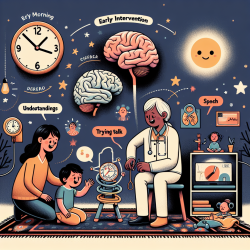Introduction
As professionals dedicated to improving child outcomes, it is crucial to stay informed about the latest research that can impact our practice. A recent study titled Modeling alcohol-induced neurotoxicity using human induced pluripotent stem cell-derived three-dimensional cerebral organoids provides groundbreaking insights into the effects of prenatal alcohol exposure. This research can guide us in enhancing our online therapy services at TinyEYE, particularly for children affected by Fetal Alcohol Spectrum Disorders (FASDs).
Research Highlights
The study utilized human induced pluripotent stem cell (iPSC)-derived cerebral organoids to model the effects of alcohol on fetal brain development. Key findings include:
- Alcohol exposure resulted in significant neurotoxicity at cellular, subcellular, and gene expression levels.
- Neurons were more vulnerable to alcohol-induced apoptosis than astrocytes.
- Alcohol exposure led to mitochondrial dysfunction and metabolic stress.
- 199 genes were significantly affected, impacting pathways related to psychiatric disorders, behavior, and nervous system development.
Implications for Practitioners
Understanding these findings can help practitioners in several ways:
1. Early Identification and Intervention
Recognizing the specific vulnerabilities in children exposed to alcohol prenatally can lead to earlier and more targeted interventions. For instance, focusing on cognitive and behavioral assessments can help identify children at risk of FASDs sooner.
2. Tailored Therapy Approaches
Given the differential impact on neurons and astrocytes, therapy can be customized to address specific deficits. For example, cognitive-behavioral strategies might be prioritized for children showing signs of neurodevelopmental delays.
3. Data-Driven Decisions
Incorporating data from studies like this into our therapy models ensures that our approaches are grounded in the latest scientific evidence. This can enhance the effectiveness of our online therapy services.
Encouraging Further Research
While this study provides valuable insights, there is still much to learn about the long-term effects of prenatal alcohol exposure and the most effective intervention strategies. Practitioners are encouraged to stay updated with ongoing research and consider participating in studies that can contribute to this growing field.
Conclusion
By integrating the findings from this study into our practice, we can improve the outcomes for children affected by FASDs. Staying informed and applying data-driven decisions in our therapy approaches ensures that we provide the best possible care for our young clients.
To read the original research paper, please follow this link: Modeling alcohol-induced neurotoxicity using human induced pluripotent stem cell-derived three-dimensional cerebral organoids.










